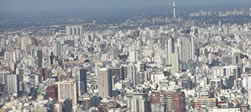 Buenos
Aires
Buenos
Aires |
As
a result of a major devaluation in its currency three years ago, Argentina
has become a relatively low cost country to visit. We planned an itinerary
for a two week trip there in August 2004. We contacted a travel agent
in Chile who had been recommended in a traveler’s posting on Frommer’s
web site and he then booked our flights within Argentina, most of our
transitions to and from airports, and most of our hotels and excursions.
Impressions
of Argentina
A number of things about Argentina surprised us. First, Buenos Aires
is very European in appearance and feel. Our other experiences in South
America have been in Ecuador and Peru. These countries are a lot like
Mexico and are very much Third World countries. Argentina on the other
hand seems very much First World - modern and prosperous. In Peru, Ecuador
and parts of Mexico, indigenous cultures are very prominent and traditional
markets are common. Nothing of this sort is seen in Buenos Aires or
in Patagonia.
Second,
the temperatures were less extreme than we anticipated. Buenos Aires
is very hot in the summer time (December-February) and Iguazu is hot
year round. We had timed our visit to escape the peak of the heat and
the peak of the crowded tourist season. But we were surprised to find
very moderate temperatures in both Buenos Aires (low 80s) and at Iguazu
Falls (high 80s).
It
was also not as cold and windy in Patagonia as we had anticipated and
the terrain was less forbidding than expected. The Peninsula Valdéz
area and the region around El Calafate were indeed rather barren with
practically no trees but they were far from bleak. The landscape was
like that of Wyoming or southern New Mexico with scrub brush and prairie
grasses. We did encounter some extremely strong winds at an overlook
where we had gone to see a colony of seals. They were strong enough
at times to require you to hold on to railings to remain upright - perhaps
60 miles an hour or even higher. With thermals and jackets, we were
never really cold in Patagonia except when exposed to the wind on the
outside boat decks while visiting Glaciers National Park.
Next,
we were surprised (and impressed) at the level of organization and efficiency
in the tourism industry. Most individual travelers and travel groups
(including Argentineans) appear to rely on local providers, who meet
flights, deliver passengers to their hotels, and provide transport to
and from scheduled excursions (such as boat trips). The providers in
each location are apparently networked in some seamless fashion. We
were unfailingly met on schedule at airports and picked up at specified
times for excursions. These agencies also reliably reconfirmed our domestic
flights (we had six of them) and our departing international flight.
This system makes it quite easy to plan and implement a complex, independent
travel itinerary. Incidentally each of our Aerolinas Argentinas flights
departed and arrived on or ahead of schedule. Without exception, the
gate agents and flight attendants were efficient and courteous and hot
or cold meals were always served, even on flights as short as an hour.
The
largest number of tourists in Patagonia other than Argentineans comes
from Italy and France. Smaller numbers come from Australia and Germany.
We usually encounter British tourists everywhere we go but we did not
see any in Patagonia. We also only met a couple of Americans.
Finally,
we were surprised at the quality (and the low cost) of the food everywhere.
Beef is king in Argentina and is traditionally prepared on large spits
indoors or outdoors. Fresh pastas are also available practically everywhere.
Pizzas are very popular and very good. With few exceptions, there is
no need to drink bottled water and fresh vegetables could be consumed
everywhere we traveled. The national snack food is empanadas (beef,
chicken, cheese and onion and numerous other varieties). These delicious
treats are available in most restaurants, even higher priced establishments,
and usually cost 45 to 60 cents each.

Empanada
Here is our trip report, organized in a day-by-day format.
DAY
1
Departed San Diego on American Airlines at 1:44 pm, March 11, 2004.
DAY
2
Arrived in Buenos Aires via Dallas at 9:16 am. Our hotel, the Aspen
Suites, was perfectly situated in the Microcenter, the principal commercial
center of Buenos Aires. If you were plopped down here and asked to guess
your location, your first response would almost certainly be somewhere
in Europe. The architecture strongly resembles that of Paris and the
numerous cafes have a Parisian look. One big difference relative to
Europe is the cost of food and lodging---a mere fraction of European
prices. The three star Aspen Suites Hotel (where we had a living room,
bedroom, full kitchen, 2 televisions, and 2 air conditioners) was $30
per night including a nice breakfast buffet. Meals at excellent restaurants
in Buenos Aires ranged from about $3 to $6. Costs were significantly
higher in Patagonia but still moderate.
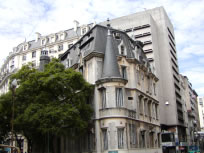
European-Styled Architecture
One
of the main shopping districts centers around Florida Street, a lively
pedestrian promenade. It doesn’t take long on this street to get
your first taste of the Tango, one of the principal preoccupations of
Argentineans. Street performers introduce the visitor to this distinctive
dance form. More elaborate performances are offered in Tango shows performed
at numerous venues every night. The other preoccupations of the country
are soccer and mate.
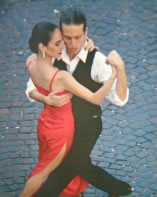
The Tango
Mate
is a medicinal and cultural beverage brewed from dried leaves steeped
in hot water and served in a gourd based cup. Argentineans can’t
do without it. For example, on outings (such as the boat to the glaciers)
many bring a thermos of hot water to make their mate throughout the
day.
DAY 3
A travel day to Iguazu Falls, 2 hours by air northwest of Buenos Aires
(17 hours by bus) in a jungle region at the border with Brazil and near
Paraguay. The little town of Puerto Igauzu is about 30 minutes from
the falls. As was true everywhere we stayed in Argentina, we readily
found excellent local restaurants in Iguazu.
DAY 4
Full day (10 hours) at Iguazu Falls, a series of stunning falls that
pretty much defy description. It was the first of three Natural World
Heritage Sites we would visit on this trip. There are 275 falls in all,
some with a vertical drop of 200 feet. Walkways on an upper and lower
circuit allow spectacular views at very close proximity.
The single most famous fall is Diablo de Gargantua (Devil’s Throat),
an exceptionally powerful cascade producing a plume of vapor that can
rise hundreds of feet into the air, visible from many miles away. Reached
by a separate walkway, an overlook places you practically on top of
this roaring inferno.
We
capped our excursion to the falls with an exhilarating speed boat excursion
in which we approached the base of two of the thunderous falls and then
actually proceeded under them (3 times!), drenching all of the delighted
passengers.
DAY
5
Travel day via Buenos Aires to Puerto Madryn. We would have liked to
visit the Brazilian side of the falls in the morning before our departure
but since the US slapped a $100 visa fee and a photo and finger-printing
requirement on Brazilians and most foreigners entering the US, Brazil
has responded in kind.
DAY
6
Full day tour of Peninsula Valdéz (2 hour drive from Puerto Madryn),
our second Natural World Heritage Site. This mostly barren peninsula
protects large colonies of elephant seals, sea lions, and Magellanic
penguins as well as guanacos (a llama-like animal) and rheas (smaller
version of the ostrich). We stopped at an overlook to see a natural
shelf supporting a large seal colony. The males were out to sea and
the females were teaching their pups how to swim in "kiddie pools"
formed by depressions on the rock shelf. It was so windy that Larry
had to hold Judi still to take photos. We're guessing the wind gusted
to 60-70 mph. Between June and December the areas off the coast serve
as an important breeding ground for the enormous and endangered southern
right whale.

Elephant Seal
DAY
7
Full day excursion to Punto Tombo, home to the largest Magellenic penguin
colony in South America. Visitors can walk through the reserve and approach
within a few feet of hundreds of nesting penguins. It is a remarkable
experience. The reserve is also a protected area for guanacos, Patagonian
hares, foxes, armadillos, and various bird species that spend part of
the year there. On the way to the airport we stopped in several Welsh
communities, having a proper tea and cakes service in Gaimon (a discrepant
experience) and visited the small but impressive Paleontology Museum
in Trelew.

Magellenic
Penguin
Evening
flight to Ushuaia. Our approach into Ushuaia was spectacular and cemented
our interest in booking an excursion on the Beagle Channel.
DAY
8
Ushuaia is the southernmost city in the world. It is located on Tierra
del Fuego, an island sliced off the bottom tip of Argentina and Chile
by the Strait of Magellan. Ushuaia is the departure point for most of
the sturdy vessels that make voyages across the Drake Passage to Antarctica.
The
town has a spectacular setting, facing the Beagle Channel. The channel
is named after the British ship on which Charles Darwin served as the
naturalist for five years, collecting the specimens that would serve
as the physical basis for his theory of evolution. The waterway is lined
with jagged snow-capped peaks. Additional high ranges rise up behind
the town so that it is almost completely encircled by mountains. Many
of the buildings, almost all of which have tin roofs, are brightly colored,
giving the town a cheery look. Except for the bustling harbor, the alpine-looking
town strongly resembles Colorado ski villages like Aspen or Telluride.
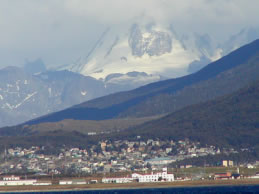
Ushuaia
Morning boat excursion on the Beagle Channel, with photo opportunities
about every 10 seconds. Afternoon was spent exploring the town, with
a stop at the Yamana Museum which documents the culture of the original
(now extinct) indigenous people of the region. It was a member of this
tribe that Fitzroy, captain of the Beagle, captured and brought back
to England to “civilize.” He was eventually returned to
his native region and within a week or so shed his English clothes and
manners for his native ways. A recent account of this cultural experiment
is presented in "Savage: The Life and Times of Jemmy Button"
by Nick Hazelwood, St. Martins Press, 2000.
DAY
9
Morning excursion by bus to Tierra del Fuego National Park, about 30
minutes from Ushuaia. The park has no unique features but is scenic
with forests and lakes and its hiking trails are very popular. Afternoon
flight to El Calafate, a small town on the shore of Lake Argentina with
a tree-lined main street. The town owes its existence almost entirely
to its proximity to Glaciers National Park.
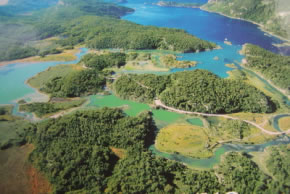
Tierra
del Fuego National Park
DAY
10
Full day boat excursion to see three major glaciers: Upsula, Spegazzini,
and Onelli. They are staggering sights, as are the blue-tinged icebergs
passed en route. The physical dimensions of these giants could not be
guessed or comprehended from the portions one sees at their leading
edges. Upsula is 37 miles long and 3-4 miles wide! Spegazzini reaches
a height of 443 feet (equal to a building of about 40 stories high).
The boat docks near Onelli. A walk of a few hundred yards through a
forest to a glacial bay culminates in a breathtaking view of Onelli.
Seeing these magnificent glaciers has peaked our interest in seeing
Alaskan glaciers and visiting Antarctica.
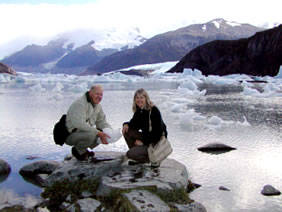
Larry and Judi at Onelli
DAY 11
Full day excursion by land to Perito Moreno, the crown jewel of Glaciers
National Park and one of the two top tourist attractions in Argentina
(along with Iguazu Falls). All we can say is…wow! You truly have
to see it to believe it. Even so, one only sees the forward most portions.
Though it is far from the largest or the tallest glacier in the national
park, it is commonly regarded as the most picturesque. It is an auditory
as well as a visual spectacle. Frequent cracks in its internal structure
produce thunderous booms and sections continuously crack and sometimes
crash into the lake at its front edge.
On
March 14, one week before our visit, a relatively rare event occurred
that was reported worldwide. The glacier's growth had created a dam
at one end of the lake at its leading edge, blocking the flow of water
into Lake Argentina. For several decades, a cycle had occurred regularly
every 4 years when the pressure created by the water caused a mighty
break in the glacier. However, the March 14 collapse was the first in
16 years and it was apparently an incredible show. The development of
a tunnel through the ice several days before made it clear that a break
was imminent and an estimated 10,000 people had rushed to the site,
some camping out at the overlook for several nights. The much-anticipated
moment did not disappoint. The collapse generated a huge wall of water
and those lucky enough to witness the event were reportedly amply rewarded
for their efforts. While we missed the main event, we did see the gaping
opening created by the break and we did see and hear one quite spectacular
calving as a double obelisk-shaped column perhaps 10 stories high broke
off and crashed into the water. Perito Moreno is most certainly one
of the most amazing (and beautiful) natural phenomena we have ever seen.
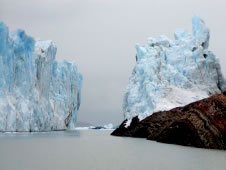
Opening
created by a glacial break.
DAY
12
Free day in El Calafate. We happened across a small museum of prehistory
and with the assistance of the director arranged an excursion by taxi
to a set of caves a few miles out of town where some 4000 year old faded
paintings could be seen. The scenery enroute was spectacular, offering
continuous views of Lake Argentina with a backdrop of high snow capped
mountains. A large eagle perched on a ridge near the caves scrutinized
our actions. Evening flight to Buenos Aires.

Watched
by an Eagle
DAYS
13-14
Free days in Buenos Aires. On our last day, we considered taking a jetfoil
to Colonia, a 17th century Portuguese fortress town, said to be quite
picturesque, on the coast of Uruguay only 50 minutes away. The entire
town has been designated a World Cultural Heritage site by UNESCO. The
return time, however, would have made our airport connection a little
too tight. So we settled for some sightseeing in Buenos Aires, including
a visit to San Telmo, the oldest section of the city. Having lunch in
the small central plaza with an accordion player nearby, we could have
been in Italy. Late evening departure for San Diego via Miami and Dallas.
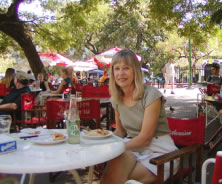
Lunch
in the San
Telmo section of Buenos
Aires.
Top |













